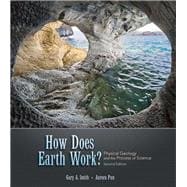
Note: Supplemental materials are not guaranteed with Rental or Used book purchases.
Purchase Benefits
What is included with this book?
| Why Study Earth? | |
| Minerals: Building Blocks of the Planet | |
| Rocks and Rock-Forming Processes | |
| Formation of Magma and Igneous Rocks | |
| Formation of Sediment and Sedimentary Rocks | |
| Formation of Metamorphic Rocks | |
| Earth Materials as Time Keepers | |
| Journey to the Center of Earth | |
| Making Earth | |
| Motion Inside Earth | |
| Deformation of Rocks | |
| Global Tectonics: Plates and Plumes | |
| Tectonics and Surface Relief | |
| Soil Formation and Landscape Stability | |
| Mass Movements: Landscapes in Motion | |
| Streams: Flowing Water Shapes the Landscape | |
| Water Flowing Underground | |
| Glaciers: Cold-Climate Sculptors of Continents | |
| Shorelines: Changing Landscapes Where Land Meets Sea | |
| Wind: A Global Geologic Process | |
| Global Warming: Real-time Change in the Earth System Why Study Climate Change? | |
| Table of Contents provided by Publisher. All Rights Reserved. |
The New copy of this book will include any supplemental materials advertised. Please check the title of the book to determine if it should include any access cards, study guides, lab manuals, CDs, etc.
The Used, Rental and eBook copies of this book are not guaranteed to include any supplemental materials. Typically, only the book itself is included. This is true even if the title states it includes any access cards, study guides, lab manuals, CDs, etc.